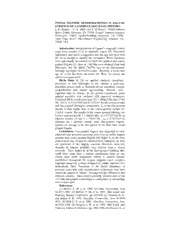
Initial Isotopic Heterogeneities in ZAGAMI: Evidence of a Complex Magmatic History PDF
Preview Initial Isotopic Heterogeneities in ZAGAMI: Evidence of a Complex Magmatic History
INITIAL ISOTOPIC HETEROGENEITIES IN ZAGAMI: EVIDENCE OF A COMPLEX MAGMATIC HISTORY. L. E. Nyquist 1, C.-Y. Shih2, and Y. D. Reese3. 1NASA Johnson Space Center, Houston, TX 77058. E-mail: laurence.e.nyquist @nasa.gov. 2ESCG Jacobs-Sverdrup, Houstson, TX 77058. 3Mail Code JE-23, ESCG/Muniz Engineering, Houston, TX, 77058, USA. Introduction: Interpretations of Zagami’s magmatic history range from complex [1,2] to relatively simple [3]. Discordant radiometric ages led to a suggestion that the ages had been reset [4]. In an attempt to identify the mechanism, Rb-Sr isochrons were individually determined for both fine-grained and coarse- grained Zagami [5]. Ages of ~180 Ma were obtained from both lithologies, but the initial 87Sr/86Sr (I ) of the fine-grained Sr lithology was higher by 8.6±0.4 e -units. Recently, a much older age of ~4 Ga has been advocated [6]. Here, we extend our earlier investigation [5]. Rb-Sr Data: In [5] we applied identical, simplified, procedures to both lithologies to test whether a grain-size dependent process such as thermally-driven subsolidus isotopic reequilibration had caused age-resetting. Minerals were separated only by density. In the present experiment, purer mineral separates were analysed with improved techniques. Combined Rb-Sr results give ages (T) = 166±12 Ma and 177±9 Ma and I = 0.72174±9 and 0.72227±7 for the coarse-grained Sr and fine-grained lithologies, respectively. I in the fine-grained Sr sample is thus higher than in the coarse-grained sample by 7.3±1.6 e -units. The results for the coarse-grained lithology are in close agreement with T = 166± 6 Ma, I = 0.72157±8 for an Sr adjacent sample [7] and T = 178±4 Ma, I = 0.72151±5 [4, Sr adjusted] for a separate sample. Thus, fine-grained Zagami appears on average to be less typical of the bulk than coarse- grained Zagami. Conclusions: Fine-grained Zagami was suggested to have inherited more numerous pyroxene cores from an earlier magma chamber than coarse-grained Zagami [1]. Higher I in the finer- Sr grained parts may in part be inherited from radiogenic Sr from old pyroxenes in the magma reservoir. However, most LIL elements in Zagami probably were derived from a crustal reservoir. Thus, higher I in the finer-grained lithology also Sr could have come from a greater contribution from an old, crustal, high Rb/Sr component. Failure to achieve isotopic equilibrium throughout the magma suggests rapid, complex, magmatic processes, perhaps initiated by sudden injection of a metasomatic fluid. Variations in the initial abundance of pyroxene cores plus early crystallization of pyroxene may have caused the magma to “choke”, freezing isotopic differences into different volumes. These effects probably affected most of the ~175 Ma shergottites contributing to ambiguities in interpreting their isotopic data. References: [1] McCoy T. M. et al. 1992. Geochim. Cosmochim. Acta 56:3571-3582. [2] McCoy T. M. et al. 1995. 26th Lunar and Planetary Science Conference. pp. 925-926. [3] Treiman A. H. and Sutton S. R. 1992. Geochim. Cosmochim. Acta 56:4059- 4074. [4] Shih C.-Y. et al. 1982. Geochim. Cosmochim. Acta 46:2323-2344. [5] Nyquist L. E. et al. 1995. 26th Lunar and Planetary Science Conference. pp. 1065-1066. [6] Bouvier A. et al. 2005. Earth and Planet. Sci. Lett. 240:221-233. [7] Borg L. E. et al. 2005. Geochim. Cosmochim. Acta 69:5819-5830.
